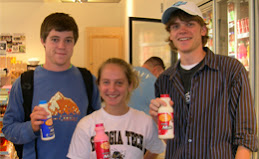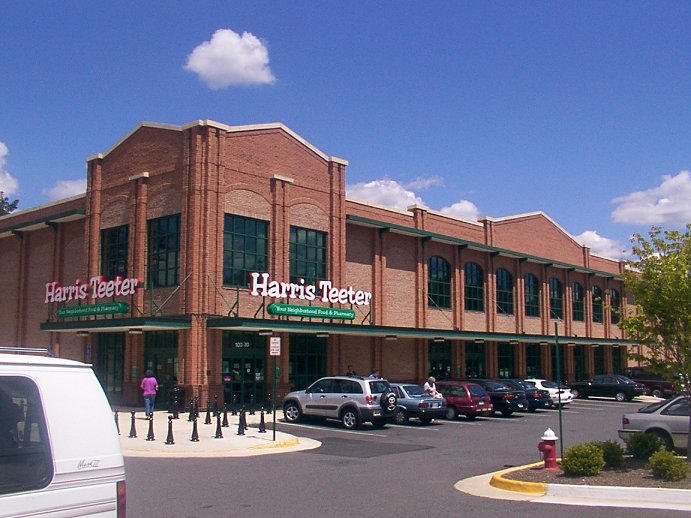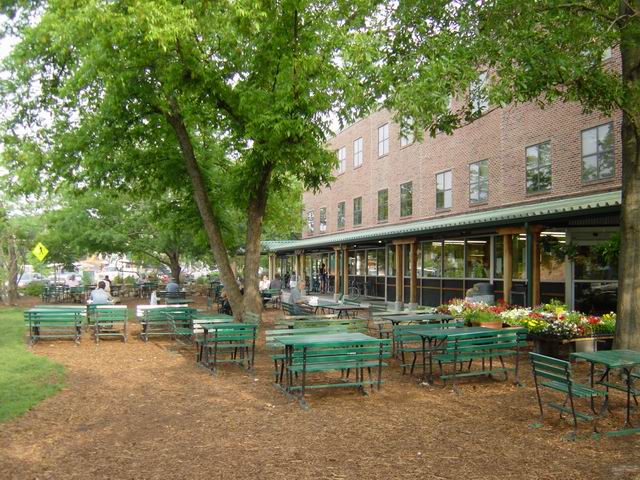Tuesday, October 2, 2007
Final Presentation
Quick note: in slide 6/11, under Harris Teeter, Harris Teeter Brand prices and Organic Valley prices were accidentally switched. Sorry about that! Harris Teeter brand was by far the cheapest available on the market.
Maps
Also, here were our official group meeting times thanks to Jack, our research coordinator.
Sept. 11th: outside of the Student Union to discuss the central question and to come up with questions that we would need to answer in order to be able to write the paper.
Sept 21st: Visited Harris Teeter to gather information on milk prices, brands, distributors etc.
Sept 26th: Met at Union to discuss future plans and how we would go about getting information from Food Lion and Weaver St. Market.
October 2nd: Met at 3:15 outside of Union to finalize plans for presentation, go over paper and figure out if we were missing anything on the rubric that needed to get done.
Monday, October 1, 2007
The Maryland and Virginia Milk Producers Cooperative Association
Information on
Hunter Farms (Harris Teeter Brands) and Food Lion brands both use M&V Milk Cooperative. Because of huge demand, however, Hunter Farms also uses Piedmont Milk (see below for more info) which is privately owned. A big question stems from the difference between private milk and cooperative milk.
M&V's logo here shows cows, the farm, the cooperative, and the final bottle of milk. Througout their website there are idyllic images of small farm, sunsets, and the association of the coop with big money. Piedmont Milk, conversely, doesn't have a website.
M&V is responsible for marketing the raw milk to processors as well as doing in house processing and balancing. This is not done by Piedmont Milk.
M&V collects raw milk and organizes buyers for it. They also schedule and organize pickup and delivery. Some clients (such as Food Lion) do not have diary processing capabilities, so production is shifted to one of the three in house fluid processing plants. The plant for Food
Lion brand in Carborro is in
Production is done independently of the Coop by individual farm owners. Profits are divided by volume produced (image courtesy of the University of Georgia).
If there is extra milk on the market from weekend production, or from a period of surplus, milk is transferred to a balancing plant. This brings up interesting economics issues—they are actively controlling the amount of supply to artificially control the price. At a balancing plant, milk is converted into a “shelf stable” form. This is milk powder, cream, or condensed milk.
All profits from the milk sales are then collected and divided by volume amongst members of the cooperative. Specifically, it is divided “per hundred weight” basis. Dairy farmers are paid a fixed price per hundred pounds of milk. Thus, a major difference between cooperatives and private distribution is that in a cooperative, farmers just produce the milk. Privately, they must find a middle man and worry about infrastructure issues associated with distribution of their product.
A major factor in comparing
Geography and the “Milk Deficit”
A large milk cooperative such as M&V Milk Cooperative will have about 1,500 milk producing families, each of whom can own several dairies. The geographical distribution of farms for M&V Milk Cooperative stretches from
-Source- Amber in the communications department (703.742.6800)
-Website- (https://www.mdvamilk.com/index.php?)
Sunday, September 30, 2007
Visual Cues
Weaver Street Market:
- No large sign with a huge logo on it when entering
- There is a large lawn outside for public gatherings
- Non-linear lay out of store
- Fewer number of total products, but greater variety within each type of food available
- More perishable goods
- Included salad, coffee, and sushi bars to encourage local consumption
- A few different companies, such as Odwalla, produce a large amount of the food in different categories. There is food imported from far away places such as France.
- Employees do not have a full uniform
- Plastic Bags are not available
- Many products are sold unpackaged
Harris Teeter
- In the same geographical location as Weaver Street Market revealing issues of competition
- Different store hours to WSM (open 24 hours a day)
- Every employee is completely uniformed
- Lots of focus on family-friendly appearance, large displays
- Larger in size
- In the milk section, locally bottled milk composes a smaller percentage
- Advertisements appear in milk area revealing price cuts
- There are references to membership benefits
- Automatic check-out to expedite customer handling
- Numerous "brands" that are all bottled by Harris Teeter- simulated options
Food Lion
- Different geographical location from other two sites
- Store roughly the same size as WSM, smaller than Harris Teeter site
- Less focus on appearance
- Employees do wear uniforms
- A number of milk brands including options not bottled by Food Lion
- Advertisements show prices in large font, while product is hardly visible
- Enormous Sign on building
- Traditional lay out of store
- Fewer perishable goods, more packaged
Friday, September 28, 2007
Piedmont Milk
Contact: Bill Moore- manager
Piedmont Milk is not a cooperative-- it is a middle man linking producers with processing plants like Hunter Farms. Under USDA Federal Orders, based on geographic boundaries, non members of cooperatives are assigned processing plants. This is because under the Copper Volstead Act, cooperatives are authorized to operate and allowed autonomy for production. Producers not in a cooperative cannot operate independently and are thus assigned processing plants.
 Image from inside a dairy showing automatic milking machines. (courtesy of the QCTimes)
Image from inside a dairy showing automatic milking machines. (courtesy of the QCTimes) Farmers milk the cows twice a day and it is moved directly into insulated holding tank cooled to between 37 and 38 degrees in less than an hour. By regulation, milk has to be removed from the farm and picked up every other day. It is then taken to a processing plant. Three tests are then done on the milk-- antibiotic check (to look for allergic reactions), cryoscopy (to look for added water), and
 bacteria pre pasteurization (to look for parts per million). The milk is then pasteurized at the bottler at 195 degrees for 2-3 minutes. After this it is homogenized to stop cream from separating and bottled.
bacteria pre pasteurization (to look for parts per million). The milk is then pasteurized at the bottler at 195 degrees for 2-3 minutes. After this it is homogenized to stop cream from separating and bottled.Milk Tanks specially cooled to store milk until pickup at the farms (Image courtesy of the Shanghai Stainless Steel Vessel Co.)

Specially cooled milk trucks are required by law to pick up milk from dairies every other day. (Image courtesy of Penn State University)
Spatial info:
Specifically for hunter farms: It is not uncommon at this time of year for surplus milk to be shipped from as far as NY or even New Mexico, however, the bulk of milk production predesignated for hunter farms comes from between Rocky Mount NC and Wyphville V.A. Primary producers are in Alagaines County, Burlington NC across to Liberty/Snow Camp NC, then on the other side of 85 producers are mainly in Statesville. From dairy to production plant is an average elapsed time of an hour.
Here is a flow chart of milk production:
-Information from phone interview with Dwight Moore of Hunter Farms and personnel from Piedmont Milk
Thursday, September 20, 2007
Related Group Projects
1. Demographics of Restaurants
*blackboard site: https://blackboard.unc.edu/webapps/portal/frameset.jsp?tab=courses&url=/bin/common/course.pl?course_id=_252113_1
This group is trying to determine which groups of people are attracted to locations such as Weaver St. Market and McDonald's. Weaver St. Market is part of our study as well, and we are also interested in who this particular location is trying to attract, via their sales of Milk.
2. Imagination/Perception of a Coffee Shop
*blackboard site: https://blackboard.unc.edu/webapps/portal/frameset.jsp?tab=courses&url=/bin/common/course.pl?course_id=_252113_1
*blog site: msfcoffee.blogspot.com
This group is comparing the perceptions between a local coffee shop and a corporately owned shop. They said they plan to interview customers and management alike to determine who the stores are trying to attract, and what the customers think of the coffee shops. This is similar to our project in that we are comparing a local market (Weaver St. Market) vs. Harris Teeter (or possibly another big name grocery store).
3. Imagination/Perception: Cosmic Cantina
*blackboard site: https://blackboard.unc.edu/webapps/portal/frameset.jsp?tab=courses&url=/bin/common/course.pl?course_id=_252113_1
This group is looking at Cosmic as their main focal location and trying to study how the Mexican food and art contribute to the groups of people who come to eat at the restaurant. They are also considering times when different groups come. This relates to our project because it again focuses on who a specific place is trying to attract.
Monday, September 17, 2007
Interesting Links
Weaver Street Market has a great website in that it is informative, and it also clues readers into the values of the company. Here is a link to the produce specific page so you can get a feel for the goals of Weaver Street's produce department:
http://www.weaverstreetmarket.coop/eating/index.php#pos7
Harris Teeter is located less than a block from Weaver Street but it's website provides some interesting contrasts. Along with being able to order food online, it also provides you with specials on food that aren't available at WSM. By examining the various links you can get more information about the brands that Teeter buys from and the guarantees they make about their products.
http://www.harristeeter.com/Default.aspx
Another interesting site to look at is the Wikipedia site about Harris Teeter. Many resources made an interesting note of the fact that one of Harris Teeter's earliest purchases as a company was of a dairy. It seems that lowering the cost of dairy products was a major focus for the company early on:
http://en.wikipedia.org/wiki/Harris_Teeter
Ram's Head Market, located below the dining hall, is an important grocery source for students that live on campus and don't have transportation to other stores. It is interesting to see that their site has the least amount of nutritional information as well as product information. The site focuses far more on noting its size and its centralized spatial location.
http://www.dining.unc.edu/ramsmarket.aspx
More interesting links to come...
As a side note, we've added a new banner. All images in the banner are original except the central image of an old milk truck which is courtesy of the New Mexico State University's history page. The link to the original image is here:
http://alamo.nmsu.edu/~lockhart/AlamMilk/chap6/truck.jpg








